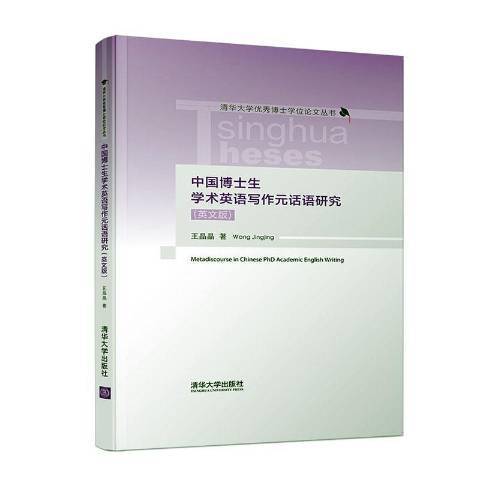《中國博士生學術英語寫作元話語研究》是2020年清華大學出版社出版的圖書。
基本介紹
- 中文名:中國博士生學術英語寫作元話語研究
- 作者:王晶晶
- 出版社:清華大學出版社
- 出版時間:2020年6月1日
- 頁數:212 頁
- 開本:16 開
- 裝幀:平裝
- ISBN:9787302544937
內容簡介,圖書目錄,
內容簡介
本書基於元話語廣義人際模式以及狹義反身模式,提出適用於學術論文寫作語篇的元話語分類模式,即元語篇、信息引導式以及人際互動式元話語的三維分類模式。其中,每一維度都是一個層級體,體現元話語在篇章中的不同功能。基於此模式嘗試探究中國理工科博士生英語學術寫作元話語的使用特徵,及其與相關領域英文期刊論文中元話語的使用差異。
圖書目錄
Contents
Chapter 1Introduction
1.1Rationale of the Study
1.2Research Objectives and Questions
1.3Significance of the Research
1.4Thesis Overview
Chapter 2Literature Review
2.1Theoretical Studies on Metadiscourse
2.1.1Definition of Metadiscourse
2.1.2Features of Metadiscourse
2.1.3Categorizations of Metadiscourse
2.2Empirical Studies on Metadiscourse in
Academic Writing
2.2.1Metadiscourse in Research Articles
2.2.2Metadiscourse in ESL/EFL
Student Writing
2.3Research Gap
2.4Summary
Chapter 3Analytical Framework of the Present Research
3.1Working Definition of Important Terms
3.1.1Defining Discourse
3.1.2Defining Academic Writing
3.1.3Defining Metadiscourse
3.2Developing an Analytical Framework for the
Present Study
3.2.1Reflexivity of Metadiscourse
3.2.2Writerreader Interaction in Metadiscourse
3.2.3Analytical Model for the Present Study
3.3Classification of Metadiscourse
3.3.1Reflexivity: Metatext
3.3.2Writerreader Interaction: Interactive
Metadiscourse
3.3.3Writerreader Interaction: Interactional
Metadiscourse
3.4Summary
Chapter 4Methodology
4.1Data Collection
4.1.1Corpora
4.1.2Interview
4.2Data Coding
4.3Data Analysis
4.4Summary
Chapter 5Results and Discussion: Metatext
5.1General Distribution Patterns of Metatext
5.2Disciplinary Similarities and Differences Between
the Two Corpora
5.3Metatext in Use
5.3.1Reference to Discourse Entities
5.3.2Reference to Discourse Acts
5.3.3Reference to Discourse Labels
5.4Summary
Chapter 6Results and Discussion: Interactive Metadiscourse
6.1General Distribution Patterns of Interactive
Metadiscourse
6.2Disciplinary Similarities and Differences Between
the Two Corpora
6.3Interactive Metadiscourse in Use
6.3.1Transition Markers
6.3.2Frame Markers
6.3.3Code Glosses
6.3.4Evidentials
6.4Summary
Chapter 7Results and Discussion: Interactional Metadiscourse
7.1General Distribution Patterns of Interactional
Metadiscourse
7.2Disciplinary Similarities and Differences Between
the Two Corpora
7.3Interactional Metadiscourse in Use
7.3.1Hedges
7.3.2Boosters
7.3.3Selfmentions
7.4Summary
Chapter 8Conclusions
8.1Major Findings
8.1.1General Patterns of Metadiscourse in the
Two Corpora
8.1.2Disciplinary Similarities and Differences in
Metadiscourse Between the Two Corpora
8.1.3Metadiscourse in Use
8.2Implications of the Study
8.2.1Theoretical Implications
8.2.2Methodological Implications
8.2.3Pedagogical Implications
8.3Limitations of the Study
8.4Suggestions for Future Studies
References
Appendix AInteractive and Interactional Metadiscourse
Items Investigated
Appendix BCategories of the Threedimensional
Analytical Model with Examples
Appendix CInterview
後記
List of Figures
List of Figures
Figure 2.1Relationship between propositional discourse and
metadiscourse17
Figure 2.2Personal and impersonal configurations of “metatext”
and “writerreader interaction”24
Figure 2.3Subtypes and the discourse functions of the proposed
taxonomy of metadiscourse26
Figure 3.1Planes of discourse level50
Figure 3.2Rhetorical triangle55
Figure 3.3Selfreflexivity of metalanguage57
Figure 3.4Reflexive triangle62
Figure 3.5Analytical model of metadiscourse for the present research67
Figure 3.6Stanceengagement model of interaction73
Figure 4.1Sample concordance lines operated by AntConc 3.5.081
List of Tables
List of Tables
Table 2.1Narrow approach to metadiscourse22
Table 2.2Broad approach to metadiscourse27
Table 3.1Functions of the reflexive model62
Table 3.2Hylands interpersonal model of metadiscourse65
Table 4.1Journal description78
Table 4.2Descriptive statistics of the corpora79
Table 4.3Demographic information of the informants80
Table 5.1Overall results of metatext86
Table 5.2Overall results of metatext across disciplines89
Table 5.3Distribution of subtypes of reference of discourse
entities in the corpora92
Table 5.4Top 5 frequently used reference to discourse entities94
Table 5.5Underused reference to discourse entities98
Table 5.6Frequencies of reference to discourse acts99
Table 5.7Top 5 frequently used reference to discourse acts102
Table 5.8Underused reference to discourse acts105
Table 5.9Frequencies of reference to discourse labels107
Table 5.10Top 5 frequently used reference to discourse labels109
Table 5.11Overused reference to discourse labels112
Table 6.1Overall results of interactive metadiscourse115
Table 6.2Overall results of interactive metadiscourse across
disciplines117
Table 6.3Subtypes of transition markers and Its different functions119
Table 6.4Distribution of subtypes of transition markers in the
corpora121
Table 6.5Top 5 frequently used transition markers123
Table 6.6Top 5 overused transition markers125
Table 6.7Underused transition markers127
Table 6.8Misuse of transition markers in CSW corpus129
Table 6.9Distribution of subtypes of frame markers in the corpora134
Table 6.10Top 5 frequently used frame markers137
Table 6.11Top 5 overused frame markers138
Table 6.12Underused frame markers140
Table 6.13Distribution of subtypes of code glosses in the corpora143
Table 6.14Top 5 frequently used code glosses144
Table 6.15Overused code glosses146
Table 6.16Underused code glosses147
Table 6.17Misused code glosses148
Table 7.1Overall results of interactional metadiscourse154
Table 7.2Overall disciplinary distributions of interactional
metadiscourse157
Table 7.3Distribution of various hedging devices in the corpora161
Table 7.4Top 5 most frequently used hedges162
Table 7.5Top 5 most frequently overused hedges163
Table 7.6Underused hedges (per 10,000 words)164
Table 7.7Distribution of booster in the corpora
(per 10,000 words)166
Table 7.8Frequencies of boosters (per 10,000 words)167
Table 7.9Top 5 most frequently used boosters168
Table 7.10Top 5 most frequently overused boosters170
Table 7.11Distribution of selfmentions in the corpora
(per 10,000 words)173
Table 7.12Discourse functions of selfmention in the corpora
(per 10,000 words)178
List of Abbreviations
List of Abbreviations
CSWChinese EFL PhD student writer corpus
EAPEnglish for academic purposes
EFLEnglish as a foreign language
ESLEnglish as a second language
JAWJournal article writer corpus
L1First language
L2Second language
MMsMetadiscourse markers
RAsResearch articles
PPhysics
LSLife science
CSComputer science and technology
MSMaterial science and engineering

